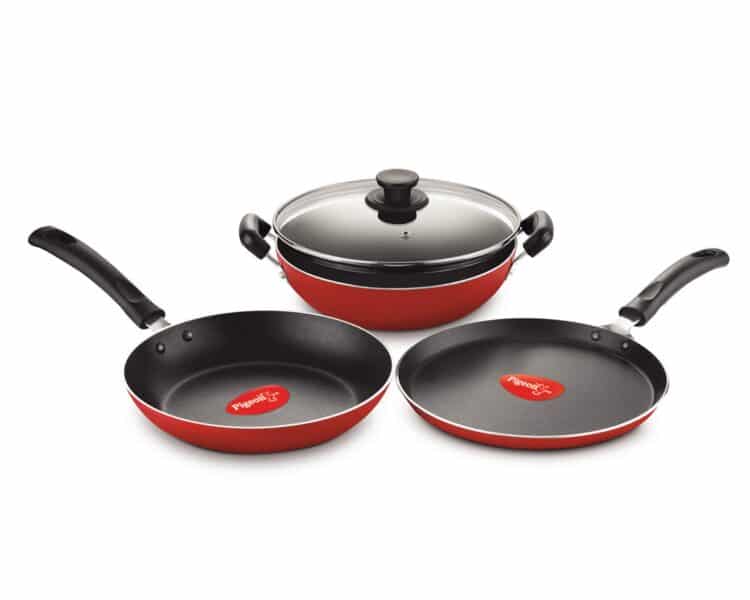For most of us, our kitchens are well equipped with different types of pans. These would range from nonstick to stainless steel, and most likely there’s a particular type that’s your favorite. Without a doubt, all these pans are aimed at making our cooking experience blissful and give us the best results whenever we embark on our meal preparation.
If you have several nonstick pans, the most common trend is to use them all the time especially due to their ease of cleaning after cooking. However, there is a time when you should alternate between a shiny metal and a non-stick pan for example, depending on what it is that you’re cooking. The question therefore remains, when do you use nonstick pans and when do you use others types instead?
We are going to answer this question based on professional chefs’ advice with the aim of helping you enjoy your cooking experience.
When to use a nonstick pan
First of all, is there a difference between a shiny metal and a nonstick pan? This is a common question among many people especially those who are only familiar with aluminum cookware. Well, there is a major difference between a nonstick pan and a shiny metal pan or regular pans in general. These two types of pans are designed to serve different purposes if you want to achieve the desirable results.
For example, if you want to cook something delicate such as a fish or to fry an egg, a nonstick pan would come in handy. However, if you’re stir frying or sautéing some vegetables, a stainless steel pan will come in handy and give you some amazing results.
The reason for this is that nonstick pans and pots are designed to prevent against any kind of sticking at the bottom, and this is commonly so when dealing with delicate foods. On the other hand, stainless steel pans are meant to give a flavorful crust when used properly. As a matter of fact, stainless steel pans are designed to allow the food to stick to a certain degree thus creating a base for sauces and gravies.
You can use stainless steel pans for purposes such as shallow frying, searing steak, salmon and poultry among other foods. With this in mind, it’s clear that there are times you should use nonstick pans and others when you should opt for stainless steel or shiny pans.
Nonstick pans are ideal when cooking different types of foods such as egg dishes, slimy and cheesy foods such as quesadillas, delicate fish and stir-fried rice noodles.
How should you use nonstick pans?
If you don’t like using a lot of cooking oil, using nonstick pans and pots would be the most ideal cookware to consider. As a matter of fact, the modern PFOA free nonstick pans are the best to use for a healthy cooking experience. As such, you only need to apply a thin coat of cooking oil on the surface of the pan in case you’re preheating it. This helps protect the chemicals consisting in the nonstick coating from reacting directly with the heat. Additionally, it’ advisable that nonstick pans should not be heated excessively or exposed to high temperature. Exposing the nonstick pans to higher temperatures would result in a damaged coating since they are not designed to work with high heat. On the other hand, it could cause a release of harmful toxins. Always check the users’ guide to see the ideal temperature under which your pan should be used.
Tips for using the nonstick pans
Proper usage of the nonstick pans will determine their lifespan and keep them in the best of conditions. On top of the aforementioned usage guidelines, the following should come in handy in helping you not only get the best results when cooking but also maintain your pan in good condition. These include the following:-
- Rub a thin coat of cooking or vegetable oil on the pan’s surface before using it for the first time. Most manufacturers recommend this for their cookware.
- Avoid preheating the pan when it’s empty. Instead, put some little oil or butter on the surface before preheating for a few seconds and then add your food.
- Instead of using a nonstick cooking spray, it’s preferable to use oils such as grape seed or vegetable oil. This is because the sprays contain lecithin which with time will affect the nonstick surface, making it gummy.
- Cook under medium or low heat. This will help protect your nonstick pan from degrading especially on the cooking surface.
- Do not use metallic utensils on a nonstick pan. Instead, use a silicone or plastic coated, nylon or a wooden spoon or spatula to stir or turn your food.
Final thoughts
Just as it’s advisable to research and read user reviews for different products, we would advise you to do the same when it comes to nonstick pans or any other cookware. You can find a list of recommended shiny metal and non-stick pans based on in-depth user reviews thus helping you get durable and trusted options in the market. If you’re looking for a recommended shiny metal and a non-stick pan to add to your kitchen, why not take time to read not only the user reviews but also understand the pros and cons associated with each? This way, you’ll not only get the best but also figure out on how to use your pan after the purchase.
Siddhi Panchal is a food blogger at CookingwithSiddhi and food aficionado who loves to cook. Her cooking skills cover a range of Indian and international cuisines. Her aim is to enable other food enthusiasts explore their love for food by helping them cook delectable dishes from India and around the world.

